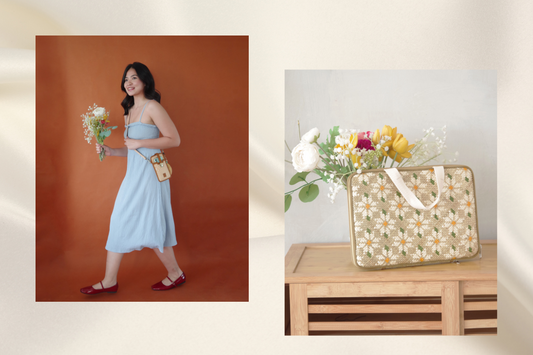
We do nothing but sit and wait.
In one section of the floor, ate Arlene crouches over a mat woven from dried tikog leaves. She is positioned near the metal gate where the morning light spills in between the bars, illuminating her workspace. Across the room, on a table near a window with half-open wooden shutters sits ate Beth. Strewn around her feet are buri strips in color-coded bundles. The sewing machine before her makes a rhythmic rat-tat-tat as she stitches lining and zipper to a piece of banig. An ashtray is behind her, within arm’s reach. Smoke from her cigarette curls upwards and forms shapes in the pale light.

It is work they have done for years. It is work I’m getting to know in the span of a few days.
Today, John tells me, our job is to watch. He is concerned that I might be bored, but I do as I am told. I watch.
I watch as ate Arlene slips dyed buri strips into the eye of a long, flat needle – pahot, the Waray call it – then pushes it into a sliver of space in the banig mat, where the weft and warp overlap. It takes a bit of force to get it under; for a second, I fear that the tikog leaves will break and rupture. But they hold. The needle resurfaces then bobs quickly as she pushes it over then under the weave. Over and under, over and under – until the aqua buri strip is fully embedded in the banig. She cuts the excess peeking out then swipes the flat side of her knife across the embroidery to flatten it. Simple.

I try it later in the same position as ate Arlene: legs apart forming an acute angle, torso bent over a clean space of banig. It’s not as easy as it looks. Pahot in hand with a length of buri trailing from it, I do the work of an embroiderer or paragpahot. The process is simple, like cross-stitching except on a bigger scale, but I go through the motions more slowly and carelessly. I successfully embroider one line of color then I do another. By the third, I am uncomfortable and shift positions, bending my right leg towards my left thigh. My butt begins to go numb. It doesn’t take ten minutes before I give up completely and go back to the relative comfort of my Monobloc chair.

All afternoon, I watch them hunched over their individual stations. Ate Beth’s sister joins in later at a separate table to stick leather onto chip board. The pungent smell of rugby fills the room. The minutes stretch into hours and we fill the silences with loose talk and gossip. I ask questions about their craft and they share little tidbits. Ate Beth has been weaving for fifteen years; ate Arlene has been an embroiderer for ten.
They do not talk as readily about themselves as most people; John tells me that the Waray have a reputation for being tough and are more skeptical about the intents or agenda of visitors, especially following the 2013 super-typhoon Yolanda. In the aftermath, volunteers flowed into the towns, eager to help (for which the locals were undoubtedly grateful for). But after they had done their work for a few days or weeks, they left and did not come back, leaving the survivors to their own devices.

John had stayed a year and immersed himself in the community. They know him and some are even friends with him. I, on the other hand, am a new face, a stranger. I still have a long way to go in terms of building relationships and making friends. So, I am thankful for the small pieces of information that they share.
Throughout the morning, people come in and out of the open gate that serves as ate Beth’s front door. A weaver or a paraglara walks in with a black “family-sized” mat and offers to sell it. The visitor names a price and ate Beth laughs in surprise, then negotiates in the local dialect. They come to an agreement and the weaver leaves the rolled-up mat by the table. She hangs around for a while and tells me before leaving that it is worth more because it takes a great amount of dyes to color the banig black.

In the afternoon, a little girl with wispy brown hair bursts into the room like a ray of sunshine. She is wearing a t-shirt and a navy school skirt, and heads for the weaver sitting on the floor. She leans over her mother’s handiwork and asks timidly, “Tapos?” Apple is ate Arlene’s youngest daughter, just six years old but already walking to and from school without supervision. Her mother doesn't answer, her eyes glued to the bobbing needle. Apple positions herself near the gate and waits the way children do – restlessly. She peers at the banig on the floor, at Ate Beth's sewing machine, then at the highway with its passing trucks and roaring tricycles. She rocks back and forth, stretches, twists, and crosses her legs. When the waiting proves to be longer than expected, she marches off to ate Beth’s living room, where her playmate, Ysabel, is watching television.


There is a part of me that wants to wander away like the little girl. I am itching to get on a habal-habal and head for somewhere greener and open-spaced. But I manage to stick to my spot, to do the job that needs to be done today, partly from a sense of duty and also a growing fascination. I watch the colors blossom on the banig as ate Arlene adds new lines of color. I am filled with wonder at her quiet intensity, at ate Beth’s air of certainty and confidence in her skill. Here are two talented individuals at peace with their craft – a refreshing take on the frenzied artist, usually shown as struggling for inspiration and at war with himself or herself. For these women are artists in their own right – artisans who specialize in the centuries-old practice of mat weaving and embroidery.

The work ends only when the light diminishes into semi-darkness. The single light bulb in ate Beth’s work area is not enough to illuminate her table, let alone the whole room. Putting her needle and knife to rest, ate Arlene swipes the buri bundles aside and rises from the floor. Despite ate Beth’s invitation to eat, she says she will have dinner at home with her family.
Tomorrow, she will be back to resume the work she began.

John and I will be in another barangay by then. But for the both of them, it will be another day of sitting and waiting. Like any craft, banig weaving demands concentration and perseverance – one that comes into fruition only under the slow, steady work of competent hands. They are patient. They must be. Because they know that patience is not just a virtue but a valuable skill that brings food to their tables. So they carry out the motions of a time-hallowed tradition, eking out a living for themselves and their families.
And in their sitting and waiting, they create.
--
Text and Photos by Trish Lim



